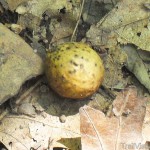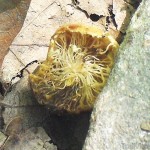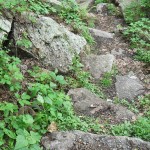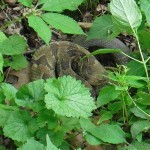I had a very interesting hike along the Peters Mountain Loop Trail today. My first surprise was that I found yet another Mystery Grape at the fifth switchback on the north-bound Appalachian Trail above the Shermans Peek Vista. This one was browning but still had the telltale speckles and urchin-like center.
The second surprise was much more dangerous.
About 2 minutes north (actually east-northeast) of Scout Rock (the seventh switchback above Shermans Peek) and 4 minutes south (actually east-southeast) of the Dauphin Overlook Vista I set my right foot down and immediately heard a quick loud rustling sound which caused me to jump and run about 15 feet before feeling safe enough to turn around and see what had startled me. It only took a second to figure out what it was; the rattling noise was a big tip-off. Less than a foot away from where I had set my foot was a large aggravated Timber Rattlesnake. It remained coiled and rattling as I nervously snapped a few pictures from a somewhat safe distance of 5 feet.
After hurrying along the remaining portion of the trail while casting a suspicious eye towards every stick and vine, I arrived safe at home and read a few herpetology websites. Apparently this particular rattlesnake was a Yellow Phase Timber Rattlesnake, and “phase” isn’t something which changes during the lifetime of the snake. The Yellow Phase Rattlesnake isn’t “going through a phase” it will always be a yellow, just like the Black Phase Rattlesnake will always be black. In this case “phase” means a distinct coloration.
PA Timber Rattlesnakes are usually found at elevations greater than 1,000 feet and emerge from their den after approximately six months of hibernation around late April or early May (my encounter happened on May 16th 2012) when they go through a period of “emergence basking” which lasts from days to weeks and serves to acclimate the snake to the warmer conditions beyond its den. This leads me to believe that this particular snake may be in the same area for a while until it disperses into the forest to hunt and mate so be careful hiking through this section of the Appalachian Trail.
[map style=”width: 600px ; height:600px ; float:left; margin:0px 30px 30px 0px; border: 1px solid gray;” maptype=”HYBRID” kml=”https://trailvistas.com/wp-content/uploads/2012/05/peters-mtn-loop-surprises.kml” elevation=”no”]
Regarding rattlesnake bites, the largest Timber Rattlesnakes (the one I saw was midsized with a diameter of about 1.75 inches) have a maximum striking distance of 3 feet, 30% of all bites are dry and don’t inject any venom, and there have NOT been any deaths in Pennsylvania attributable to Timber Rattlesnakes for at least the past 25 years. If you do get bitten remain calm, avoid physical exertion and get to a hospital as soon as possible.
Timber rattlers do an excellent job of blending in with their surroundings. Even though my eyes were glued to the trail three feet ahead of me as I scanned for the next “mystery grape”, I still failed to notice the snake right on the edge of the trail until it made a noise to alert me. Be safe out there.





Better start carrying some anti-venom with you.
Nice pics. Be careful out there.
That’s a beautiful snake. I’m glad all he did was just let you know he was watching you! I enjoyed the herpitology lesson, too. I think of the 4 types of poisonous snakes in the US, the coral’s venom is the worst.
Vista pictures are gorgeous – look professional!
You’re the second person to call the Timber Rattler beautiful, I’ll agree that it’s neat looking but I wouldn’t hang its picture on my wall.
oh that’s nice…for school we had to climb that mountain trail twice.and without any equipment, i almost fell off the mountain because something crawled over my foot, i think it was a mouse or something.